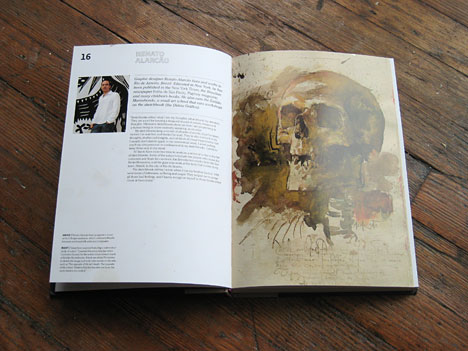Book Review: Sketchbooks: The Hidden Art of Designers, Illustrators and Creatives

Midway through Richard Brereton's Sketchbooks: The Hidden Art of Designers, Illustrators and Creatives, commercial artist and graphic designer Ed Fella confides, "in 1976 an artist friend gave me a sketchbook, saying 'Even though you're a designer, you think like an artist and should keep a sketchbook.'" Well, even if you happen to be a designer and you don't think like an artist, we at Core77 still think you should carry a sketchbook. Whether it's a modest moleskine with battered corners stuck in your back pocket or a fancy leather tome, sketchbooks can serve as practice pages, ways to fill time, as a finished products, or even what graphic designer Pep Carrio beautifully describes as "warehouses of memory."

Historically, artists have often self-edited their sketchbooks by tearing out pages or censoring their output. While it's hard to discern exactly what editorial oversight Richard Brereton performed when he chose which particular plates would make it into his compilation of sketchbooks by design professionals, he clearly did not limit his search to classically drawn figures. Instead Sketchbooks presents a diverse range of styles, subject matter, and even artistic skills, and that's a good thing. Anyone who has perused a collection of portfolios or taken a drawing class intuitively understands that being "loose" is high praise. When an artist gains the confidence to draw with brio, sketches gain vibrancy and pop off of the page. For most of us, the state of mind that allows lines to be drawn with snap seems like the exclusive provenance of artists with this thing called "talent," or perhaps a lucky few who've practiced for lifetimes. Fortunately, Brereton's collection proves otherwise. While some of the graphic artists contained within have produced work that could be described as "fine art," and many others seem childlike or crude, virtually all of them draw like no one is looking; and perhaps that's precisely the essence to which a sketchbook should aspire.

While looking at the notebooks of a Da Vinci, I'm stricken simultaneously with awe and despair by his utter mastery of line and form, but Brereton sets us a far more reasonable bar. With Da Vinci a reader might feel compelled to meticulously copy the masters work, but by including both "wow" and "I could do that" moments, Brereton's readers might actually be inspired to pick up a pencil. Some of the artists included, like Renato Alarcao, with his antiqued watercolor skull and calligraphic script look, like they could have been torn from Da Vinci, but others, like Johnny Hardstaff's hyper-detailed pen and ink work, are literally a world away. The picture-perfect sketchbooks are impressive, but the real inspiration comes from the lighter stuff: the silly two-dimensional figures of Dominic Del Torto's fractured world and the white-out covered (but still technically precise) line art of freelance illustrator Seb Jarnot. While the maxim is a tired one, it is also true, and the artists' occasional visible mistakes make their artwork their own and Brereton manages to showcase a lot of mistakes (and I mean this in the kindest way, especially for the artists who were willing to open the pages of their books, which is tantamount to opening up their souls for all to see).

Beyond offering visible reasons for designers to draw, Sketchbooks demonstrates just how many ways playing artist with a sketchbook can serve a designer. Paulus Driebholtz uses his sketchbooks directly for work, carefully drafting his recent innovations in typography and font design. More telling than any of his meticulous lettering or his perfectly slanted caligraphy, however, is the words "IN CASE YOUR FIND THIS BOOK, PLEASE RETURN IT TO: PAULUS M. DREIBHOLZ," demonstrating perhaps more clearly than any other page just how precious a pile of paper and some smudges of ink can be. While her stark-hatched ink figurative illustrations are as different as can be from Paulus's, Lauren Simkin Berke feels the same way, stating, "If there were to be a fire in my building, and I had a moment to grab one thing before running out, I would take the small suitcase of my sketchbooks from the last two years." When you finally close Brereton's book and you manage to pick up a sheaf of bound pages (as you should), perhaps you'll wind up filling pages with tattoos of loopy Ink daubed faces and borderline-schizophrenic graphomania like author Henrik Delehag. Perhaps you won't. No matter what your style, I can guarantee you'll share one thing with all of the professionals here: for the rest of your life your sketchbook will be one of the most important things in it. After all, it is your heart on that page.

-
oFavorite This
-
QComment
K
{Welcome
Create a Core77 Account
Already have an account? Sign In
By creating a Core77 account you confirm that you accept the Terms of Use
K
Reset Password
Please enter your email and we will send an email to reset your password.

